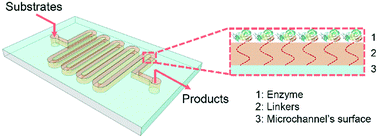当前位置:
X-MOL 学术
›
React. Chem. Eng.
›
论文详情
Our official English website, www.x-mol.net, welcomes your feedback! (Note: you will need to create a separate account there.)
Microfluidic immobilized enzyme reactors for continuous biocatalysis
Reaction Chemistry & Engineering ( IF 3.9 ) Pub Date : 2019-09-16 , DOI: 10.1039/c9re00217k Yujiao Zhu 1, 2, 3, 4, 5 , Qingming Chen 1, 2, 3, 4, 5 , Liyang Shao 4, 6, 7, 8 , Yanwei Jia 4, 9, 10, 11, 12 , Xuming Zhang 1, 2, 3, 4, 5
Reaction Chemistry & Engineering ( IF 3.9 ) Pub Date : 2019-09-16 , DOI: 10.1039/c9re00217k Yujiao Zhu 1, 2, 3, 4, 5 , Qingming Chen 1, 2, 3, 4, 5 , Liyang Shao 4, 6, 7, 8 , Yanwei Jia 4, 9, 10, 11, 12 , Xuming Zhang 1, 2, 3, 4, 5
Affiliation

|
Biocatalysis has attracted significant attention owing to its environmental-friendly nature, high efficiency, and remarkable selectivity for reactions. However, enzymes, which are powerful catalysts used in biocatalysis, suffer from low stability when used for long-term operations in solution and a gradual decrease in activity during storage. Microfluidic reactors are devices known for their smaller dimensions, large surface-to-volume ratios, and well-defined reaction times. Enzymes immobilized in such microfluidic reactors can exhibit distinct benefits, such as fast reaction rate, high storage stability, suppressed autolysis, and ease of use. The use of microfluidic immobilized enzyme reactors (μ-IMERs) offers several advantages over traditional technologies in performing biocatalytic reactions, such as low energy consumption, rapid heat exchange, fast mass transfer, high efficiency, and superior repeatability. In this review, the strategies of employing μ-IMERs for continuous biocatalysis have been investigated via a top-down approach. First, from the macroscopic perspective, the fabrication techniques of microfluidic reactors are presented encompassing materials, configurations, and technologies. Then, from the microscopic point of view, several strategies are discussed for the internal structural designs of microfluidic reactors. Moreover, when we move to the nanoscopic level, attention is paid to the choice of enzyme immobilization techniques for performance enhancement. Finally, the scalability of microfluidics that transfers biocatalysis from laboratory to industrial production was investigated. This review is intended to provide a guideline for using biocatalysis in microreactors and expediting the progress of this important research area.
中文翻译:

用于持续生物催化的微流固定酶反应器
生物催化由于其环境友好的性质,高效率和显着的反应选择性而引起了广泛的关注。但是,作为在生物催化中使用的强力催化剂的酶,在溶液中长期使用时稳定性低,在保存过程中活性逐渐降低。微流体反应器是以其较小的尺寸,较大的表面体积比和明确定义的反应时间而闻名的装置。固定在这种微流体反应器中的酶可以表现出独特的优势,例如快速的反应速度,高的存储稳定性,抑制的自溶作用和易于使用。与传统技术相比,使用微流体固定酶反应器(μ-IMER)在进行生物催化反应方面具有许多优势,例如低能耗,快速热交换,快速传质,高效率和卓越的可重复性。在这篇综述中,研究了使用μ-IMERs进行连续生物催化的策略通过自上而下的方法。首先,从宏观的角度,介绍了微流体反应器的制造技术,包括材料,构造和技术。然后,从微观的角度,讨论了微流控反应器内部结构设计的几种策略。此外,当我们迈向纳米级时,应注意选择酶固定技术以提高性能。最后,研究了将生物催化从实验室转移到工业生产中的微流控技术的可扩展性。这篇综述旨在为在微反应器中使用生物催化提供指导,并加快这一重要研究领域的进展。
更新日期:2019-12-18
中文翻译:

用于持续生物催化的微流固定酶反应器
生物催化由于其环境友好的性质,高效率和显着的反应选择性而引起了广泛的关注。但是,作为在生物催化中使用的强力催化剂的酶,在溶液中长期使用时稳定性低,在保存过程中活性逐渐降低。微流体反应器是以其较小的尺寸,较大的表面体积比和明确定义的反应时间而闻名的装置。固定在这种微流体反应器中的酶可以表现出独特的优势,例如快速的反应速度,高的存储稳定性,抑制的自溶作用和易于使用。与传统技术相比,使用微流体固定酶反应器(μ-IMER)在进行生物催化反应方面具有许多优势,例如低能耗,快速热交换,快速传质,高效率和卓越的可重复性。在这篇综述中,研究了使用μ-IMERs进行连续生物催化的策略通过自上而下的方法。首先,从宏观的角度,介绍了微流体反应器的制造技术,包括材料,构造和技术。然后,从微观的角度,讨论了微流控反应器内部结构设计的几种策略。此外,当我们迈向纳米级时,应注意选择酶固定技术以提高性能。最后,研究了将生物催化从实验室转移到工业生产中的微流控技术的可扩展性。这篇综述旨在为在微反应器中使用生物催化提供指导,并加快这一重要研究领域的进展。



























 京公网安备 11010802027423号
京公网安备 11010802027423号